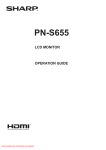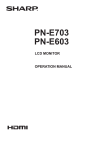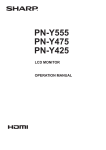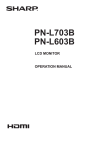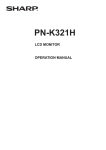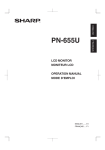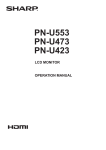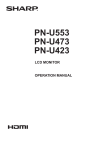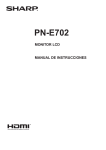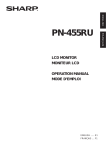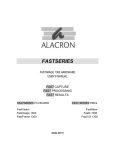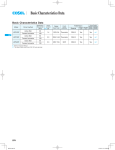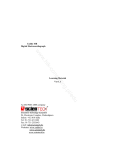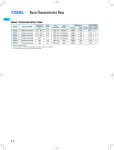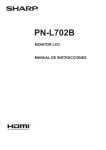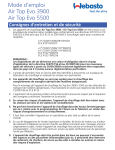Download Sharp PN-425 user manual Tv User Guide Manual Operating
Transcript
PN-425 LCD MONITOR OPERATION GUIDE Downloaded From TV-Manual.com Manuals Contents Basic Operation................................................................3 Menu Items........................................................................5 Displaying the menu screen..........................................5 Menu item details..........................................................6 Adjustments for PC screen display.............................10 Initialization (Reset)/Functional Restriction Setting.... 11 Controlling the Monitor with a PC.................................12 PC connection.............................................................12 Communication conditions..........................................12 Communication procedure..........................................12 RS-232C command table............................................14 This guide contains instructions regarding operation, settings, and similar details. For instructions regarding connection and installation, refer to the included Operation Manual. Manual Scope - Microsoft and Windows are registered trademarks of Microsoft Corporation. - Adobe, Acrobat, and Reader are either registered trademarks or trademarks of Adobe Systems Incorporated in the United States and/or other countries. - All other brand and product names are trademarks or registered trademarks of their respective holders. - Language of OSD menu used in this manual is English by way of example. - Illustrations in this manual may not exactly represent the actual product or display. - This manual assumes use in horizontal orientation, except where specifically noted. 2 E Downloaded From TV-Manual.com Manuals Basic Operation 3. MODE (Screen mode selection) Each time you press this button, the screen mode changes in the following order: 1 STD (Standard) → OFFICE*1 → VIVID → sRGB*2 → STD (Standard) ... 3 2 *1Display brightness is lowered. (This mode saves power.) *2When the input mode is DIGITAL/ANALOG1/ANALOG2. sRGB is international standard of color representation specified by IEC (International Electrotechnical Commission). Color conversion is made in taking account of liquid crystal’s characteristics and represents color tone close to its original image. 4 6 5 7 8 4. SIZE (Screen size selection) Each time you press this button, the screen size changes in the following order: (See page 4.) WIDE → ZOOM1 → ZOOM2 → NORMAL → Dot by Dot → WIDE ... 1. INPUT (Input mode selection) The menu is displayed. Press or to select the input mode, and press to enter. * You can select the input terminal by pressing the input switch of the monitor. Input mode DIGITAL ANALOG1 PC input ANALOG2 AV input Video Audio PC digital RGB input terminal PC analog RGB input terminal PC audio input terminal Audio input terminals (VIDEO) 2. DISPLAY Displays monitor information. The display disappears when this button is pressed again or disappears automatically after approximately 15 seconds. INFORMATION ANALOG1 INPUT MODE : ANALOG1 SIZE : WIDE MODE : STD BRIGHT : 22 VOLUME : 15 OFF TIMER : 10:59 ID No. : MODEL : PN-425 S/N : 1024x768 V: 60 Hz Pressing or displays the VOLUME menu when the menu screen is not displayed. VOLUME Audio input Component video input terminals COMPONENT terminals (COMPONENT) VIDEO 6. MENU Displays and turns off the menu screen (see page 5). 7. VOL +/- (Volume adjustment) PC analog RGB input terminals (BNC) Composite video input terminals or S-video input terminal 5. MUTE Turns off the volume temporarily. Press the MUTE button again to turn the sound back to the previous level. 15 Press or to adjust the volume of the sound. * If you do not press any buttons for about 4 seconds, the VOLUME menu automatically disappears. 8. BRIGHT +/- (Backlight adjustment) Pressing or displays the BRIGHT menu when the menu screen is not displayed. BRIGHT 15 Press or to adjust the brightness. * If you do not press any buttons for about 4 seconds, the BRIGHT menu automatically disappears. 0 Downloaded From TV-Manual.com Manuals H: 48.4 kHz 3 E Basic Operation nSwitching the screen size Even when the screen size is changed, the display may remain the same depending on the input signal. WIDE ZOOM1 PC input Displays image so it fills the entire screen. AV input An image with a 4:3 aspect ratio is stretched to fill the entire screen. PC input An image with a 4:3 aspect ratio is enlarged to fill the entire screen without changing the aspect ratio. The edges of the image may be cut off. AV input ZOOM2 PC input Use this size if ZOOM1 cuts off the subtitles. AV input NORMAL Dot by Dot PC input Displays image so it fills the screen without changing the aspect ratio of the input signals. AV input Displays the entire image of the aspect ratio of 4:3 without changing the aspect ratio. PC input Displays the dots of the signals input from the connected PC as the corresponding dots on the screen. AV input Displays the dots of the input signals as the corresponding dots on the screen. * * Displays 1080i images at reduced size so that they fill the entire screen. TIPS • Using this monitor’s screen-size switching or dual-screen display functions to compress or expand the screen for commercial or public viewing in establishments like cafes or hotels may infringe on the rights of the creators, as protected by Copyright Law, so please be careful. • When ENLARGE is set, the screen size is fixed to WIDE mode. • When dual-screen display is selected, the screen size cannot be changed. • The appearance of the original video may change if you select a screen size with a different aspect ratio than the original image (e.g. TV broadcast or video input from external equipment). • When an ordinary non-wide image (4:3) is viewed with the whole screen using the screen-size switching function of this monitor, the edge of the image may be lost or appear distorted. If you wish to respect the creator’s intentions, set the screen size to NORMAL. • When playing commercial software, parts of the image (like subtitles) may be cropped. In this case select the optimal screen size using the screen-size switching function of this monitor. With some software, there may be noise or distortion at the edges of the screen. This is due to the characteristics of the software, and is not a malfunction. • Depending on the original image size, black bands may remain at the edges of the screen. 4 E Downloaded From TV-Manual.com Manuals Menu Items Displaying the menu screen nMenu screen display 1 Video and audio adjustment and settings of various functions are enabled. This section describes how to use the menu items. See pages 6 to 8 for details of each menu items. GAIN CONTROL MANUAL nExample of operation (Adjusting CONTRAST in the GAIN CONTROL menu) 1. Press to display the menu screen. ADJUSTMENT MANUAL 127 50 149 27 H-POS V-POS V: 60 Hz H: 48.4 kHz 2. Press to display the GAIN CONTROL menu. 3. Press to select CONTRAST. GAIN CONTROL 44 4 1024x768 V: 60 Hz H: 48.4 kHz TIPS • Items that cannot be selected appear in gray. (e.g. Function not supported by the current input signal) ANALOG1 BLACK LEVEL 68 CONTRAST 44 1024x768 V: 60 Hz or H: 48.4 kHz to adjust the setting. GAIN CONTROL MANUAL ANALOG1 AUTO BLACK LEVEL 68 CONTRAST 50 1024x768 5. Press 68 CONTRAST AUTO MANUAL 4. Press BLACK LEVEL 3 1 Name of the menu 2 Input mode 3 An item being selected (highlighted) 4 Screen resolution of input signal, and other data. RESET 1024x768 ANALOG1 AUTO ANALOG1 AUTO CLOCK PHASE ● 2 V: 60 Hz H: 48.4 kHz to close the menu screen. TIPS • The menu will differ depending on the input mode. • The menu screen will close automatically if no operation is performed for about 15 seconds. Downloaded From TV-Manual.com Manuals 5 E Menu Items Menu item details The menu will differ depending on the input mode. nADJUSTMENT (ANALOG1/ANALOG2) MANUAL/AUTO Adjusts CLOCK, PHASE, H-POS, and V-POS. If you are using a Windows PC, use the adjustment pattern on the supplied CD-ROM. (See page 10.) MANUAL����� Selects and adjusts CLOCK, PHASE, H-POS, and V-POS. AUTO���������� Use this automatic adjustment when you use the PC analog RGB input terminal or PC analog RGB input terminals (BNC) to display a PC screen for the first time or when you change the setting of the PC. (See page 10.) CLOCK Adjusts frequency for sampling clock for applicable video. Adjust when there is flickering in the form of vertical stripes. When using the adjustment pattern (see page 10), make adjustments so that no vertical stripe noise appears in it. PHASE Adjusts sampling clock phase for applicable video. Useful when small characters appear with low contrast and/ or there are flickers at corners. When using the adjustment pattern (see page 10), make adjustments so that no horizontal stripe noise appears in it. * Adjustments to PHASE should be made only after CLOCK has been correctly set. H-POS Adjust the horizontal position of the image. V-POS Adjust the vertical position of the image. RESET resets the values of the ADJUSTMENT menu Pressing items to the factory preset values. nGAIN CONTROL (DIGITAL/ANALOG1/ANALOG2) MANUAL/AUTO (ANALOG1/ANALOG2) Adjusts BLACK LEVEL and CONTRAST. If you are using a Windows PC, use the adjustment pattern on the supplied CD-ROM. (See page 10.) MANUAL����� Selects and adjusts BLACK LEVEL and CONTRAST. AUTO���������� Automatically adjusts BLACK LEVEL and CONTRAST. BLACK LEVEL Adjusts the entire brightness of the video signals. CONTRAST Adjusts the brightness of the image. nCOLOR CONTROL (DIGITAL/ANALOG1/ANALOG2) WHITE BALANCE THRU�������������� Displays the input signal level as is. (for DIGITAL only) PRESET��������� Selects the color temperature using PRESET. USER�������������� Used for adjusting R-CONTRAST, G-CONTRAST, and B-CONTRAST respectively. PRESET Allows selection from the preadjusted settings. (For a guide to the color temperatures of the adjustment values, see page 8.) R-CONTRAST Adjusts red component when WHITE BALANCE is set to USER. G-CONTRAST Adjusts green component when WHITE BALANCE is set to USER. B-CONTRAST Adjusts blue component when WHITE BALANCE is set to USER. COPY TO USER SET������������� Pressing copies the value set for PRESET to the USER setting. GAMMA Select a gamma value. 6 E Downloaded From TV-Manual.com Manuals Menu Items nVIDEO ADJUSTMENT (COMPONENT/VIDEO) CONTRAST Adjusts the light areas of the image. BLACK LEVEL Adjusts the entire brightness of the video signals. TINT Adjusts the hue. Selecting + changes the color towards green, and selecting - changes it towards magenta. COLORS Adjusts the color intensity. SHARPNESS Adjusts the sharpness of the image. WHITE BALANCE Allows selection from the preadjusted settings. (For a guide to the color temperatures of the adjustment values, see page 8.) GAMMA Select a gamma value. nMODE SELECT 1 480 LINES (ANALOG1/ANALOG2) If a computer connected to the PC analog RGB input terminal or the PC analog RGB input terminals (BNC) outputs resolutions of 640 x 480 or 848 x 480, select the relevant horizontal resolution. 768 LINES (ANALOG1/ANALOG2) If a computer connected to the PC analog RGB input terminal or the PC analog RGB input terminals (BNC) outputs resolutions of 1024 x 768, 1280 x 768, or 1360 x 768, select the relevant horizontal resolution. ENLARGE H Sets the number of screen splits (number of monitors) in the longer direction used for the enlargement. (See page 9.) ENLARGE V Sets the number of screen splits (number of monitors) in the shorter direction used for the enlargement. (See page 9.) ENLARGE-POS H/ENLARGE-POS V Specify the split screen to be displayed when the enlargement function is used. (See page 9.) BEZEL H/BEZEL V Sets the frame width of the display when the enlargement function is used. (H: Width of the shorter side, V: Width of the longer side) MULTI ZOOM nMODE SELECT 2 OFF TIMER Set the time until the monitor turns off (enters standby mode) between 0 and 23 in units of one hour. This function is disabled when “0” is specified. OSD H-POSITION Adjusts the horizontal display position of menu screen. OSD V-POSITION Adjusts the vertical display position of menu screen. LANGUAGE Sets the display language for the menu screen. Pressing displays the selection menu. POWER ON DELAY You can delay the screen display after the monitor is turned on. The period can be set up to 60 seconds in units of one second. When this function is activated, the power LED flashes in orange. This function is disabled when “0” is specified. ID No. SET Assigns ID numbers to monitors using RS-232 cables. The numbers 1 to 255 are available for ID numbers. If “0” is set, the system regards this as the state where no ID number is set. This should normally be set to “0”. MONITOR Select the installation direction of the monitor. LANDSCAPE......Horizontal orientation PORTRAIT.........Vertical orientation SCAN MODE (COMPONENT/VIDEO) Sets the scan mode used for AV mode input. MODE1����Over-scan display MODE2����Under-scan display MODE3����Under-scan display when the input signal is 1080i. Otherwise, over-scan display * Even when MODE1 is selected, under-scan display is used when the input signal is 1080i and the screen size is Dot by Dot. COLOR SYSTEM Selects the video signal system for AV equipment connected to the S-video input terminal and composite video input terminals (PAL/PAL-60/SECAM/NTSC (3.58)/NTSC (4.43)). If AUTO is selected, the system is automatically set according to the input signal. Adjusts the enlarged screen. Pressing displays the next menu. IMAGE ZOOM��Adjusts the scale of enlargement. H-POS��������������Adjusts the position of the longer direction. V-POS��������������Adjusts the position of the shorter direction. AUDIO Adjust the volume of the sound output from the speaker. Pressing displays the next menu. TREBLE�����������Adjusts the volume of treble-level sound. BASS����������������Adjusts the volume of bass-level sound. BALANCE���������Adjusts the balance of the audio sound between right and left. Downloaded From TV-Manual.com Manuals 7 E Menu Items nMODE SELECT 3 PIP MODES (See page 9.) Sets the display method. OFF���������Displays one screen. PIP�����������Displays a sub screen inside a main screen. PbyP��������Displays a main screen and a sub screen in a line. PbyP2������Displays a main screen which measures 1024 pixels in the longer direction and a sub screen in a line. PIP SIZE Sets the size of the sub screen in PIP mode. PIP H-POS Adjusts the horizontal position of the sub screen in PIP mode. PIP V-POS Adjusts the vertical position of the sub screen in PIP mode. PIP SOURCE (VIDEO) Selects the input signal of the sub screen in PIP, PbyP, or PbyP2 mode. SOUND CHANGE Sets the sound which is output in PIP, PbyP, or PbyP2 mode. If the main screen is displayed as a full screen by the AUTO OFF function, the sound for the main screen is output even when the sound for the sub screen is specified. PbyP2 POS Sets the position of the sub screen in PbyP2 mode. AUTO OFF Sets the display method when no signals for the sub screen are input in PIP, PbyP, or PbyP2 mode. AUTO............. Displays the main screen as a full screen. MANUAL........ Displays a main screen and a black sub screen. TIPS • When WHITE BALANCE is set to THRU, BLACK LEVEL, CONTRAST and GAMMA cannot be set. • When MODE is set to sRGB or VIVID, COLOR CONTROL cannot be set. (DIGITAL/ANALOG1/ANALOG2) • When MODE is VIVID, WHITE BALANCE and GAMMA cannot be set. (COMPONENT/VIDEO) 8 E Downloaded From TV-Manual.com Manuals nGuide to the color temperatures of the adjustment values The following is a guide to the color temperatures of the respective adjustment values for WHITE BALANCE. • Factory-adjusted value is “13” (approx. 9,000K). • The setting values are shown for reference. The color temperature of the screen varies over time. This function is not intended to keep the color temperature constant. Adjustment value Color temperature (K) 15 app. 10,000 14 app. 9,500 13 app. 9,000 12 app. 8,500 11 app. 8,000 10 app. 7,500 9 app. 7,000 8 app. 6,500 7 app. 6,000 6 app. 5,500 5 app. 5,000 4 app. 4,500 3 app. 4,000 2 app. 3,500 1 app. 3,000 Menu Items nDual screen display You can display the following screens simultaneously. • VIDEO and DIGITAL/ANALOG1/ANALOG2 • VIDEO and COMPONENT Set this function with PIP MODES in the MODE SELECT 3 menu. (See page 8.) PIP A sub screen is displayed inside a main screen. Main screen Sub screen PbyP Sub screen PbyP2 Main screen Sub screen In horizontal orientation A main screen and a sub screen are displayed in a line. Displays a main screen which measures 1024 pixels in the longer direction and a sub screen in a line. ENLARGE H 1 ENLARGE V Main screen Setting procedure In the MODE SELECT 1 menu, set ENLARGE H/V and ENLARGE-POS H/V. (See page 7.) 1. Set the number of monitors aligned in the longer direction in ENLARGE H. 2. Set the number of monitors aligned in the shorter direction in ENLARGE V. 3. Set the section of the separated image to be displayed on each monitor in ENLARGE-POS H and ENLARGE-POS V. 2 3 4 1 (1,1) (2,1) (3,1) (4,1) 2 (1,2) (2,2) (3,2) (4,2) 3 (1,3) (2,3) (3,3) (4,3) 4 (1,4) (2,4) (3,4) (4,4) * The currently selected input signal is displayed on the main screen. TIPS In vertical orientation ENLARGE V 4 3 2 1 (1,4) (1,3) (1,2) (1,1) 1 (2,4) (2,3) (2,2) (2,1) 2 (3,4) (3,3) (3,2) (3,1) 3 (4,4) (4,3) (4,2) (4,1) 4 ENLARGE H • You might infringe on a copyright of the author which is protected by copyright law when you display the images of the computer screen and television/VCR simultaneously for profit-making or to show the image to the public. • The screen size for dual-screen display is the same as the screen size for single-screen display. The Dot by Dot screen is displayed in NORMAL size except when it is set as the PIP main screen. • When dual-screen display is selected, the screen cannot be enlarged. MONITOR settings cannot be changed either. nEnlarge • You can align several monitors and integrate them into a single large screen to display. • Up to 4 monitors can be aligned in both the longer and shorter directions. • Each monitor displays enlarged views of separated images. (Example) Longer direction: 2 monitors Shorter direction: 2 monitors Longer direction: 3 monitors Shorter direction: 2 monitors Downloaded From TV-Manual.com Manuals * The numbers in parentheses are the setting values in (ENLARGE-POS H, ENLARGE-POS V) format. TIPS • Up to 4 monitors can be linked in daisy chain using PC analog RGB output terminals. • For connections other than those indicated above, a separate splitter for the video signal (commercially available) is required. • Dual-screen display is disabled when the enlargement function is used. • To cancel the enlargement, set “1” for ENLARGE H and ENLARGE V respectively. 9 E Menu Items Adjustments for PC screen display nAutomatic adjustment When you use the PC analog RGB input terminal or PC analog RGB input terminals (BNC) to display a PC screen for the first time, or when you change the setting of the PC, use the automatic screen adjustment. 1. Switch the input to ANALOG1 or to ANALOG2 and display the adjustment pattern. (See the description below.) 2. Press to display the ADJUSTMENT menu. and select AUTO. 3. Press The automatic adjustment is complete in several seconds. 4. Press 6 times to close the menu screen. TIPS • If the screen cannot be adjusted properly with one automatic adjustment, repeat the automatic adjustment 2 or 3 times. Try manual adjustment if necessary. nScreen display for adjustment Before making adjustments in the ADJUSTMENT menu or GAIN CONTROL menu, display an image to brighten the entire screen. If you are using a Windows PC, use the adjustment pattern on the supplied CD-ROM. Opening the adjustment pattern 1. Load the supplied CD-ROM into the computer’s CDROM drive. 2. Open the CD-ROM in [My Computer]. 3. Double-click [Adj_uty.exe]. The adjustment pattern will appear. Adjust the screen automatically or manually. 4. When adjustment is finished, press the [Esc] on the computer’s keyboard to quit the adjustment program. 5. Eject the CD-ROM from the CD-ROM drive. TIPS • If the display mode on the computer you are using is 65,000 colors, the color levels in the color pattern may appear differently or grayscale may appear to be colored. (This is due to the specifications of the input signal and is not a malfunction.) 10 E Downloaded From TV-Manual.com Manuals Initialization (Reset)/Functional Restriction Setting You can return the settings to their factory-preset values and restrict operations. 1. After pressing , and for about 5 seconds, press , , in that order. FUNCTION 1 ALL RESET ALL RESET ADJUSTMENT LOCK OFF 1 OSD DISPLAY OFF ON LED OFF ON TEMP ALERT OFF OSD&LED RS-232C LOCKED 2 LED UNLOCKED OK...[MENU] 2. Select and set the items. ALL RESET Resets the settings to the factory default settings. After initialization, turn the main power switch off and then back on. ADJUSTMENT LOCK You can disable operations on the monitor and the remote control unit that use buttons. OFF���Enables operation. 1��������Disables all operations other than turning power on/off and FUNCTION 1. 2��������Only the FUNCTION 1 operation is enabled. Disables all operations other than FUNCTION 1 (not even power on/off). OSD DISPLAY Hides/shows menus. The FUNCTION 1 screen cannot be hidden. LED Specifies whether to light power LED. TEMP ALERT Selects the notification method for an abnormal temperature. OFF�������������� Do not notify about an abnormal temperature. OSD&LED���� When an abnormal temperature is detected, the power LED flashes in red and green alternately and the screen displays a message: TEMPERATURE. LED�������������� When an abnormal temperature is detected, the power LED flashes in red and green alternately. RS-232C Specifies whether to allow control via RS-232C (see page 12). LOCKED������� Disables control via RS-232C. UNLOCKED� Enables control via RS-232C. 3. Press to return to the normal screen. Downloaded From TV-Manual.com Manuals 11 E Controlling the Monitor with a PC You can control this monitor from a PC via RS-232C (COM port) on the PC. Communication procedure PC connection When a command is sent from the PC to the monitor, the monitor operates according to the received command and sends a response message to the PC. Connect with RS-232 straight cable between the PC’s COM port (RS-232C connector) and the RS-232C input terminal on the monitor. nCommand format Return code C1 C2 C3 C4 P1 Command field (4 prescribed alphanumerical characters) P2 P3 P4 Parameter field (4 character string comprised of: 0-9, +, -, space, ?) Example: VOLM0030 VOLM 30 RS-232C input terminal PC To COM port RS-232 straight cable (commercially available) * Be sure to input 4 characters for the parameter. Pad with spaces (“ ”) if necessary. (“ ” is a return code (0DH, 0AH or 0DH)) Wrong : VOLM30 Right : VOLM 30 When inputting a negative value, specify a numerical value in 3 digits. Example: AUTR-009 Communication conditions Set the RS-232C communication settings on the PC to match the monitor’s communication settings as follows: Baud rate 9600 bps Stop bit 1 bit Data length 8 bits Flow control None Parity bit None Do not use spaces for MPOS. Specify parameters using 6 numerical characters. Example: MPOS010097 If a command has “R” listed for “Direction” in the “RS-232C command table” on page 14, the current value can be returned by using “?” as the parameter. Example: VOLM ? ? ? ? ← From PC to monitor (How much is current volume setting?). 30 ← From monitor to PC (Current volume setting: 30). * If an ID number (see page 7) has been assigned (For example, ID number = 1). VOLM 30 12 E Downloaded From TV-Manual.com Manuals 001 ? ← From PC to monitor. ← From monitor to PC. Controlling the Monitor with a PC nResponse code format When a command has been executed correctly O K Return code (0DH, 0AH) A response is returned after a command is executed. When a command has not been executed E R R Return code (0DH, 0AH) TIPS • “ERR” is returned when there is no relevant command or when the command cannot be used in the current state of the monitor. • If communication has not been established for reasons such as a bad connection between the PC and monitor, nothing is returned (not even ERR). If execution of the command is taking some time W A I T Return code (0DH, 0AH) “WAIT” is returned. In this case, a value will be returned if you wait a while. Do not send any command during this period. When control via RS-232C is locked (to prevent use) using the operation lock function (see page 11) L O C K E D Return code (0DH, 0AH) nCommunication interval • After OK or ERR is returned, you must send the following commands. To set a timeout for the command response, specify 10 seconds or longer. • Provide an interval of 100 ms or more between the command response and the transmission of the next command. VOLM0020 OK Interval of 100 ms or more INPS0001 WAIT OK TIPS • When turning the power on while the POWER ON DELAY function is in use, set the timeout period to the POWER ON DELAY period + 10 seconds or longer. Downloaded From TV-Manual.com Manuals 13 E Controlling the Monitor with a PC RS-232C command table How to read the command table Command: Command field (See page 12.) Direction: W When the “Parameter” is set in the parameter field (see page 12), the command functions as described under “Control/Response Contents”. ?” in the R The returned value indicated under “Reply” can be obtained by setting “????” or “ parameter field (see page 12). Parameter: Parameter field (See page 12.) Reply: Response (Returned value) *: “Yes” indicates a command which can be used in power standby mode. “No” indicates a command which cannot be used in power standby mode. TIPS • To specify the horizontal/vertical positions for vertical orientation, specify the values for horizontal orientation. Power control/Input mode selection Function Power control Command POWR Direction Parameter W Reply 0 Control/Response contents * Switches to standby mode. 1 Returns from standby mode. R 0 Standby mode Yes 1 Normal mode 2 Input signal waiting mode Input mode selection INPS W 0 Toggle change for input mode. 1 DIGITAL: DVI 2 ANALOG1: Analog RGB 3 COMPONENT: Component 4 VIDEO: S-Video/Video 5 Reserved (ERR code returned) 6 ANALOG2: Analog RGB (BNC) R Yes 1 DIGITAL: DVI 2 ANALOG1: Analog RGB 3 COMPONENT: Component 4 VIDEO: S-Video/Video 6 ANALOG2: Analog RGB (BNC) Video adjustment (When PC digital RGB input is used: DIGITAL) Function WHITE BALANCE GAIN CONTROL THRU Parameter Reply 0 PRESET 1-15 1-15 USER 99 99 Control/Response contents * Yes R-CONTRAST CRTR WR 0-128 0-128 G-CONTRAST CRTG WR 0-128 0-128 B-CONTRAST CRTB WR 0-128 0-128 BLACK LEVEL BLVL WR 0-60 0-60 CONTRAST CONT WR 0-60 0-60 GAMM WR 0-2 0-2 0: 1.8, 1: 2.2, 2: 2.4 Yes PXCK R - Returns current resolution in the form of hhh, vvv. No WIDE WR 1 1 WIDE 2 2 NORMAL 3 3 Dot by Dot 4 4 ZOOM1 5 5 ZOOM2 Resolution check SIZE (Screen size selection) 14 Direction WR 0 GAMMA Input resolution Command CTMP E Downloaded From TV-Manual.com Manuals Yes Yes Controlling the Monitor with a PC Video adjustment (When PC analog RGB/PC analog RGB (BNC) inputs are used: ANALOG1/ANALOG2) Function ADJUSTMENT GAIN CONTROL WHITE BALANCE Command Direction Control/Response contents Reply ASNC W 1 CLOCK CLCK WR 0-255 0-255 PHASE PHSE WR 0-63 0-63 H-POS HPOS WR 0-500 0-500 Adjusts the position of the longer direction. Maximum value depends on resolution. V-POS VPOS WR 0-100 0-100 Adjusts the position of the shorter direction. RESET ARST W 1 AUTO AGIN W 1 BLACK LEVEL BLVL WR 0-127 0-127 CONTRAST CONT WR 0-127 0-127 PRESET CTMP WR 1-15 1-15 99 99 USER CRTR WR 0-128 0-128 G-CONTRAST CRTG WR 0-128 0-128 B-CONTRAST CRTB WR 0-128 0-128 GAMM WR 0-2 Resolution check PXCK R Pixel setting PXSL WR SIZE (Screen size selection) WIDE WR * No No R-CONTRAST GAMMA Input resolution Parameter AUTO Yes Yes 0-2 0: 1.8, 1: 2.2, 2: 2.4 - Returns current resolution in the form of hhh, vvv. Yes 0 0 768) Reserved (ERR code returned) 1 1 768) 1360 x 768 2 2 768) 1280 x 768 3 3 768) 1024 x 768 4 4 480) Reserved (ERR code returned) 5 5 480) 848 x 480 6 6 480) 640 x 480 1 1 WIDE 2 2 NORMAL 3 3 Dot by Dot 4 4 ZOOM1 5 5 ZOOM2 No Yes Video adjustment (When component video/composite video inputs are used: COMPONENT/VIDEO) Function VIDEO ADJUSTMENT CONTRAST Command Direction Parameter Control/Response contents Reply CONT WR 0-60 0-60 BLACK LEVEL BLVL WR 0-60 0-60 COLORS COLR WR 0-60 0-60 TINT TINT WR 0-60 0-60 SHARPNESS SHRP WR 0-20 0-20 WHITE BALANCE CTMP WR 1-15 1-15 GAMMA GAMM WR 0-2 0-2 0: 1.8, 1: 2.2, 2: 2.4 SIZE (Screen size selection) WIDE WR 1 1 WIDE SCAN MODE Resolution check RESO R SCAN WR Downloaded From TV-Manual.com Manuals Yes 2 2 ZOOM1 3 3 ZOOM2 4 4 NORMAL 5 Input resolution 0-2 * Yes Yes 5 Dot by Dot - 480i, 480p, 1080i, 720p, 576i, 576p No 0-2 0: MODE1, 1: MODE2, 2: MODE3 Yes 15 E Controlling the Monitor with a PC Common input controls Function PIP PbyP PbyP2 PIP MODES PIP SIZE Sub screen position Direction WR MWSZ WR Parameter 0 Control/Response contents Reply 0 1 1 PIP 2 2 PbyP 3 3 PbyP2 0 0 SMALL 1 1 MEDIUM 2 2 LARGE WR 0-100 0-100 Adjusts the position of the longer direction. MVPS WR 0-100 0-100 Adjusts the position of the shorter direction. Sub screen position (Batch specification) MPOS WR 0-100,0-100 0-100,0-100 Specify the position in MPOSxxxyyy format (xxx: Longer side, yyy: Shorter side position). Returns a response in (xxx,yyy) format. PIP SOURCE MWIP WR 1 1 DIGITAL: DVI PbyP2 POS AUTO OFF MWAD MW2P MOFF WR WR WR 2 2 ANALOG1: Analog RGB 3 3 COMPONENT: Component 4 4 VIDEO: S-Video/Video 5 - Reserved (ERR code returned) 6 6 ANALOG2: Analog RGB (BNC) 1 1 MAIN 2 2 SUB 0 0 POS1 1 1 POS2 2 2 POS3 0 0 MANUAL 1 1 AUTO TREBLE AUTR WR -10-10 -10-10 BASS AUBS WR -10-10 -10-10 BALANCE AUBL WR -10-10 -10-10 VOLUME VOLM WR 0-31 0-31 MUTE WR 0 0 OFF 1 1 ON ID number OFTM ID no. setting WR OFTR R IDST W 0 0 OFF 1-23 Set time for OFF TIMER Value Remaining time R ID no. setting (Once) IDSL ID no. setting (Subsequent) IDLK INFORMATION W W Sets the monitor’s ID number. (“0” means “no ID number”.) Automatically set with IDST001+. 0-255 Sets a monitor ID number. This ID number is only effective for the command immediately after this command. 0 Clears the ID number if one has been designated. 1-255 Sets a monitor ID number. This ID number is effective for the next and all subsequent commands after this command. 0 Clears the ID number if one has been designated. IDCK W MODEL INF1 R Value S/N SRNO R Value BMOD WR MODE (Screen mode selection) 0 ID: xxx IDLK: yyy Displays the product serial number. 0 0 STD (Standard) 1 1 OFFICE 2 2 VIVID 3 3 sRGB (When the input mode is ANALOG1/ANALOG2/DIGITAL) 0-31 Brightness 0 OSD ON BRIGHT VLMP WR 0-31 RSET W 0 OSD DISPLAY LOSD WR 0 1 1 OSD OFF ADJUSTMENT LOCK ALCK WR 0 0 OFF TEMP ALERT POWER ON DELAY 16 OFLD TALT PWOD E Downloaded From TV-Manual.com Manuals WR WR WR Yes Yes Yes Yes Yes No No Yes Yes Yes Displays monitor’s own ID number and the selected ID number on the screen. ALL RESET LED (Power LED) Yes Returns the monitor’s ID number. 1-255 ID check Yes Yes 1-23 0-255 Yes Yes MUTE OFF TIMER * OFF MHPS SOUND CHANGE AUDIO Command MWIN Yes Yes Yes No 1 1 1 2 2 2 0 0 LED ON 1 1 LED OFF 0 0 TEMP ALERT OFF 1 1 TEMP ALERT OSD&LED 2 2 TEMP ALERT LED 0 0 POWER ON DELAY OFF 1-60 1-60 POWER ON DELAY ON Yes Yes Yes Yes Yes Controlling the Monitor with a PC Function LANGUAGE Command Direction LANG WR Parameter 14 DSTA 1 1 DEUTSCH 2 FRANÇAIS 3 3 ITALIANO R * ENGLISH 2 4 Temperature sensor Control/Response contents Reply 14 4 ESPAÑOL 0 Internal temperature normal 1 Internal temperature abnormal (Standby mode) 2 Internal temperature abnormal (Temperature is normal now, but it was abnormal during operation.) 3 Internal temperature abnormal (Brightness of the backlight decreases.) Yes Yes 4 Temperature sensor abnormal Temperature ERRT R Value Returns temperature at temperature sensors 1 and 2 in the form of xxx, yyy. Fan error monitoring ERRF R 0 Fan normal 1 Fan error COLOR SYSTEM CSYS WR 0-5 0-5 0: AUTO, 1: PAL, 2: PAL-60, 3: SECAM, 4: NTSC 3.58, 5: NTSC 4.43 Yes STDR WR 0-1 0-1 0: LANDSCAPE, 1: PORTRAIT Yes EMAG WR 0 0 OFF MONITOR ENLARGE Ratio BEZEL H 1 1 2x2 2 2 3x3 3 3 4x4 EMHV WR 00-44 00-44 1 x 1 (OFF) to 4 x 4 (“m x n” is expressed as “mn”, where m and n are the numbers of monitors specified for the longer direction and the shorter direction respectively.) BEZH WR 0-100 0-100 Bezel width of shorter side BEZEL V BEZV WR 0-100 0-100 Bezel width of longer side Image position (M x N) EPHV WR 11-44 11-44 Specify values in the order of ENLARGE-POS H/ENLARGE-POS V. (See page 9.) See the description below. Image position (2 x 2) EPOS WR 0-3 0-3 Image position (3 x 3) EPOS WR 0-8 0-8 0-15 Image position (4 x 4) Obtain cause of last standby mode EPOS WR 0-15 STCA W 0 No Yes No Initialization R 0 No detectable error has occurred 1 Standby mode by remote control unit 2 Standby mode by monitor button 3 Standby mode by RS-232C 4 Waiting mode by NO SIGNAL (Incl: VESA DPMS/DMPM) 5 Standby mode by fan error 6 Standby mode by abnormal temperature 7 Standby mode by OFF TIMER operation Yes • Image position (EPOS) setting In horizontal orientation 2x2 3x3 4x4 0 1 0 1 2 0 2 3 3 4 5 4 6 7 8 8 12 3 1 2 5 6 7 9 10 11 13 14 15 In vertical orientation 2x2 2 0 3 1 3x3 4x4 6 3 0 7 4 1 8 5 2 12 13 14 15 Downloaded From TV-Manual.com Manuals 0 8 4 9 5 1 10 6 2 11 7 3 17 E PN-425 G EN08K(1) Downloaded From TV-Manual.com Manuals


















